英语基础模块一unit教案
英语1基础模块职高英语一教案范例(教案)
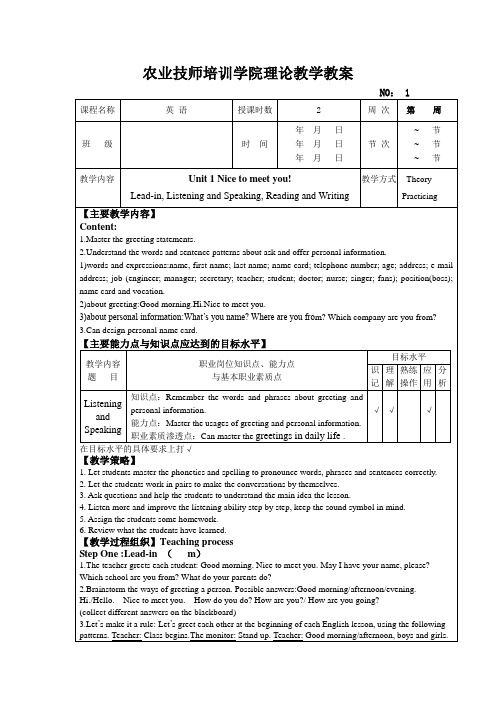
4. Activity 3. Act and practice. How would you greet a person in the following situations?
Step Two: Listening and speaking ( m)
3.Remember how todesign apersonalname card.
【学生学习情况检测】( m)
1. Practice the dialogue with your partner and underline the sentences about asking one’s personal information.
1.Activity 4. Listen and underline.
Listen to dialogue A and underline the sentences about greeting a person.
2.Practice a similar dialogue with your partner.
7.Ask some pairs to demonstratetheirperformance(greet each other and ask for personal information).
8.Activity 12. Talk and complete. Talk to five classmates and ask about their first name, last name and which school they are from.And then fill in the form.
中职英语基础模块教案
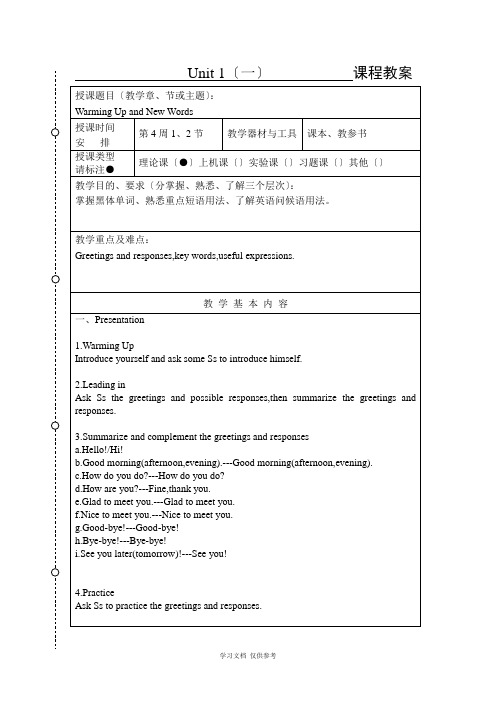
Welcome to... Look at... Be glad to do... A lot of... Thank...for...
Next to... There be... ...be glad to do... Do you see...?
句子:
1.Welcome to Xinhua Vocational School.
b.Good morning(afternoon,evening).---Good morning(afternoon,evening).
c.How do you do?---How do you do?
d.How are you?---Fine,thank you.
e.Glad to meet you.---Glad to meet you.
五、Summarize
总结Unit 1中重点单词、句子、语法。
六、Homework
Preview Unit 2.
教学过程设计:
一、Check (10mins)
Check the homework.
二、Review (10mins)
1. Reviewgrammar.
2. Reviewthe text and write the Reading Comprehensive Part.
从整体情况看,掌握程度一般。
授课类型
请标注●
理论课〔●〕上机课〔〕实验课〔〕习题课〔〕其他〔〕
教学目的、要求〔分掌握、熟悉、了解三个层次〕:
掌握短语和句型的用法、熟悉元音音标、了解国际音标。
教学重点及难点:
所学短语、句型的灵活运用。
教学基本内容
一、Check
Check the homework.
中职英语基础模块教案1

Unit one Welcome to our school (reading)1、掌握重要单词welcome glad hard visit thankwant readstudyafter love2、重要短语的识记与运用Welcome to be glad todo a lot of教学重点:学习并掌握文章中的重要句型教学难点:文中精彩句子的熟练运用教学方法:讨论法、练习法教学过程:一、复习检查(听写、小组互查)①本单元重要单词。
welcome meet glad class lethard visitwant later deskread studyafter selovetime chair 。
②重要短语的识记与运用Welcome tobegladto do look at a lot of二、出示目标,自主学习互相讨论,找出文章中重要短语、句型1、重要短语①a lot of (lots of) ②next to③welcometo④be glad to do⑤lookat⑥a lotof2、重要句型①welcome to xinhuavocational school.②I’m glad tomeet youhere。
③Therearefour reading rooms inthe libr④How large itis !⑤Thank youforyour visit!⑥Can youseeared building next tothe三、知识点导学1、那儿有许多男孩和一个女孩。
2、这楼多么高啊!3、老师的办公室紧挨着我们的教室。
4、在大街上你可以看到很多人。
5、能够帮助你我很高兴。
6、谢谢你的帮助。
填空:1、I’m happy to ________(hear )from you 。
2、There____(be) a computerand four reading roomsin the library。
《英语1(基础模块)》电子教案(教学设计)Unit 1
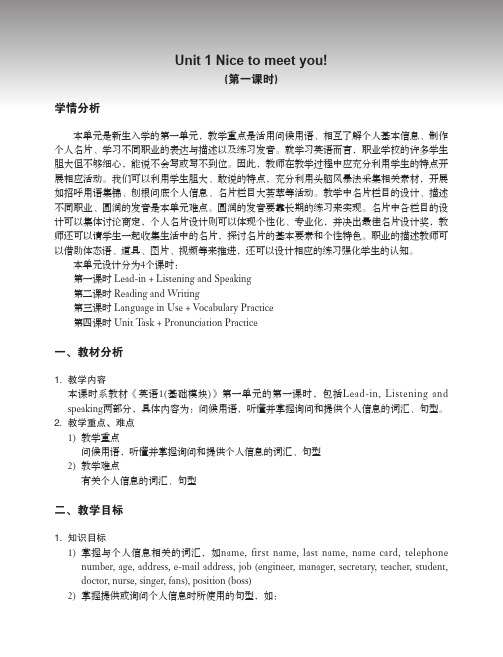
3. Let’s make it a rule: Let’s greet each other at the beginning of each English lesson, using the following patterns. Teacher: Class begins. The monitor: Stand up. Teacher: Good morning / afternoon, boys and girls. Students: Good morning / afternoon, teacher. (设计意图:固定课堂开始时的招呼问候语,问候时间适当增长,可以固定纪律,增进
Unit 1
• • • • • • • • What is your favorite city in China? What is your favorite color? What is your favorite day of the week? Why? What is your favorite drink in summer? What is your favorite food? What is your favorite holiday? Why? What is your favorite book? What is your favorite kind of movie?
3. What else would you like to know about your classmates? Ask them the following questions and make an introduction to your classmates. • What is your favorite animal?
中职英语基础模块第一单元教案1

5. Follow the disk and try to imitate the pronunciation and tones.
6.Practise:
(1)Pair work: Follow the example and make dialogues.
(2)Learn the words. Then listen and complete the passage.
Reading the new words and phrases loudly and repeat.
Knowingsome cultures and customs of foreign countries, and then canretell.
Doing pair work to make a conversation.
Finishing homework carefully.
10
10
10
15
10
10
10
15
情感态度价值观Knowing the differences of different places and cultures.
教学
重点
难点
Teaching main points and difficult points:
1. Students can grasp the key words and sentences involved.
授
课
题
目
Unit 1 Nice people, nice places
Part One: Warming up, Listening and Speaking
教
学
英语(基础模块)第一册第01-unit1教案

第8课时:练习课。听写、评价作业。巩固提高学生的学习内容,达到复习巩固、评价反馈、拓展延伸的作用,同时帮助学生将所学知识和技能系统梳理,提升学习效果,并增强学生自信心。
二、分课时教学设计
第1-2课时
教学
目标
语言知识目标:1.熟练常见国家名称,如China, UKБайду номын сангаас USA, Australia,
Egypt,France, etc.;以及由此延伸出的常见国籍的表达
或Are you from…或Is it a beautiful place询问该同学;或者用Where is she / he from 或Is he / she from…问其他同学。通过几轮练习,激活学生掌握几句基本句型。
3.请同学们看首页大图,介绍本单元课题。让学生通过标题NicePeople, Nice Places猜测本课学习内容及词汇。
利用图示理论,减少二语学习中母语的干扰。
由机械性操练过渡到半开放性操练,学生有更多思考的机会。
7’
练习
游戏——哪里人:教师请学生每人在卡片上写一个国家名和姓名并收集起来,例如:America, Britain等。由提问的学生抽卡片向全班出示,并用Where are you from提问;被抽到的同学按照提示回答:I’m from America. I’m American.提问同学又问:How do you find it?
英语基础模块1电子教案

英语基础模块1电子教案-CAL-FENGHAI-(2020YEAR-YICAI)_JINGBIAN英语基础模块1电子教案【篇一:基础模块1电子教案(上)】unit 1 nice to meet you !课程名称:英语使用教材及出版社:《英语基础模块1第2版》高等教育出版社教学课型:技能课课时:共9课时教学目标:语言知识目标:学生能够理解并运用在不同场景下的简单问候语,能够使be动词的一般现在时介绍个人及他人信息。
语言技能目标:听——学生能够听懂在不同场景下的简单问候语。
说——学生能够在不同场景下用简单的问候语问候他人。
读——学生能够读懂名片上的信息。
写——学生能够根据个人情况做出自己的名片。
学习策略:学生学习将事物归类排序的能力。
文化意识:学生掌握中文人名与英文国家人名的不同排序规则。
情感态度:学生了解不同的职业,并初步确定自己的求职意向。
单元任务:学生能运用所学语言拟定自己未来的名片。
教学重点:学生能够理解并运用在不同场景下的简单问候语。
教学难点:学生能够使be动词的一般现在时介绍个人及他人信息。
学情分析:学生处于中职英语学习的第二年,英语基础和技能仍然较薄弱,通过第一年自编教材的学习,口语技能和英语基础知识有一定的训练和提高。
教学方法:活动教学法、任务教学法、情景教学法教学准备:ppt、audio file for listening教学过程:period 1-2:words expressionsstep 1 lead-int greets ss: nice to see you again! last term, we got along well with each other. i hope we can spent a happy term from now on.t help ss read all the new words correctly.step 2 new contentt helps ss have a general idea of the usage of some important words.1. firsta. 第一的,最先的(置于名词之前时,通常与the或one’s连用)eg. the first month of the year 一年的第一个月the first three pages of the book 这本书的前三页it was my first visit to europe. 那是我第一次去欧洲。
(完整版)英语基础模块上册unit1教案

Unit 1 nice to meet you!Period 1【教学目标】语言知识目标:A) 词汇:first, last, telephone, number, age, address, e-mail,engineer,street, company, manager, secretary, patient, vocational, nurse, name card, vocational school.B)句型: Hello!/Hi!Good morning/ good afternoon/ good evening.I’m…..Nice to meet you!/ Nice to meet you too.Where are you from?教学重点和难点1.重点:A) 认知新词汇:first, last, telephone, number, age, address, e-mail,engineer,street, company, manager, secretary, patient, vocational, nurse, name card, vocational school.B) 认知last name 和first name 在中西方的差异。
2.难点:语言功能:Enable students greet peple in English.情感目标:A) 激发学生学习英语的兴趣,发挥学生学习英语的主动性。
B) 通过小组活动、组间竞赛等,培养学生的合作意识和团队精神。
C) 学习英语文明礼貌的询问和回答方式。
学习策略:A)认知策略:为完成学习任务而自觉采取一些适合自己的学习方法和手段。
B)交际策略:学会与他人合作交流,并能把语言材料用到真实的生活情景中去。
C)资源策略:学会利用一切可利用的学习资源,如学习用品,字典,录音机和网络等获取更多的信息。
D)调控策略:在学习的过程中,通过自我评价和反思,不断调整自己的学习方法。
unit1(外研社 英语基础模块第一册)教案
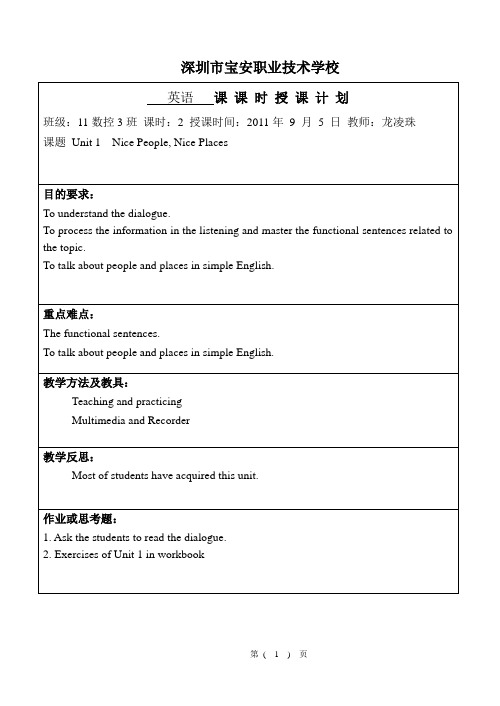
深圳市宝安职业技术学校课时授课计划(副页)深圳市宝安职业技术学校课时授课计划(副页)深圳市宝安职业技术学校课时授课计划(副页)深圳市宝安职业技术学校单项选择题:1.There are two ________ in the street.A. America policemanB. American policemanC. American policemen2. There are five ________ Canadian tourists in Shenzhen.A. hundredB. hundredsC. hundred of3. They are three _______.A. man secretaryB. men secretariesC. men secretary4. There are eleven _________ in the village.A. women heroB. women heroesC. woman heroes5. We are looking at thousands of _________.A. toothB. teethC. tooths6. It has __________feet.A. hundreds ofB. hundred ofC. hundreds7. There are six ________ birds.A. hundredB. hundredsC. hundreds of8. There are many ________ in the street.A. leafsB. leavesC. leafes9. They are four ________.A. FranceB. FrenchC. Frenchmen10. They are eight ________.A. GermanyB. GermansC. Germen11. The woman has two ________ boys.A. twelve-years-oldB. twelve-year-oldC. twelve years old12. It is a _______ truck.A. six meter longB. six-meters-longC. six-meter-long13. I write a ________ article.A. five-hundred-wordB. five-hundreds-wordsC. five hundred words14. This river is _________.A. two-hundred-meter-longB. two-hundred-mters-longC. two hundred mters long15. The baby is only________.A. one-month-oldB. one months oldC. a-month-old。
职高英语基础模块1高等教育unit1教案第三课时

Book1 Unit 1 Nice to meet you!(第三课时教学设计)一、教材分析1.教学内容本课时系教材《英语1》(基础模块高教版)第一单元的第三课时,包括language in use和vocabulary consolidation两部分,具体内容为:be动词的用法和名片各栏目词汇的表达,职业词汇收集。
2.教学重点、难点⑴教学重点be动词的用法和主题词汇的积累,未来职业的描述⑵教学难点主题词汇的积累二、教学目标1.知识目标⑴掌握与名片设计相关的主题词汇,如name, first name; last name; name card; telephone number; age; address; e-mail address; job (engineer; manager; secretary; teacher; student; doctor; nurse; singer; fans); position(boss).⑵掌握be动词的用法。
(3)能描述自己或他人的职业。
2.能力目标⑴学生能清晰表达名片各栏目.⑵学生能熟练掌握职业词汇以及be动词的用法。
3.情感目标学生清楚自己的职业梦想,建立初步的就业意识。
三、教学步骤(英文)Step One Lead—in (10m)1。
Have a comment on the students’ name cards. Pass the cards around the class.(设计意图:教师及时对学生的作业作出评价,对优秀作业的集体肯定,可以促使学生更积极主动地做作业。
)2. Ask the students to present and talk about the name cards they have collected in groups。
Use the following sentence patterns。
His name is …He is from …He is a …His telephone number is …(设计意图:读懂名片信息,掌握动词be的用法之一:用is的情况.)Step Two Language in use (20 m)1.Game: Who am I? The teacher says “I'm thinking of something and you guess what it is.” The teacher can describe anything that the students are familiar with, however, the teacher should use “am”as many times as possible。
高教社英语基础模块1电子教案新版Unit
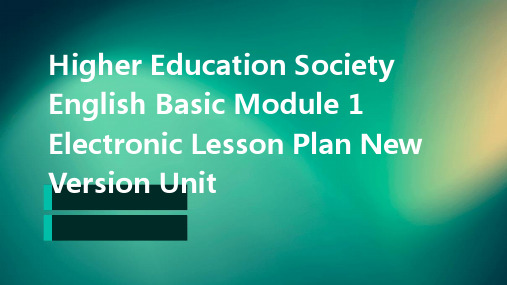
3
Provide preview guidance to guide students on how to effectively preview.
Guidance on preview methods
Guide students to obtain preview materials through various channels,
• Interactive method: Encourage students to actively participate in classroom activities through forms such as teacher-student interaction and student student interaction, deepening their understanding and mastery of new knowledge.
Introduce the learning objectives and key points of this lesson to students, and help them clarify their learning direction.
Selection of presentation methods for new knowledge
• Exploration method: Guide students to discover the patterns and characteristics of new knowledge through independent exploration, cooperative learning, and other methods.
To foster students' interest in learning English and enhancing their self confidence in using the language
高教版中职英语基础模块1全套教案

高教版中职英语基础模块1全套教案教案一:Unit 1 Introduction to English教学目标:1. 了解英语的起源和发展历程。
2. 学习英语的基本发音规则和语音特点。
3. 掌握英语的基本问候语和自我介绍的表达方式。
教学重点:1. 英语的起源和发展历程。
2. 英语的基本发音规则和语音特点。
3. 英语的基本问候语和自我介绍的表达方式。
教学难点:1. 英语的发音规则和语音特点的掌握。
2. 自然流利地运用英语的问候语和自我介绍。
教学准备:1. 多媒体设备。
2. 讲义和练习题。
教学过程:Step 1: Lead-in1. Greet the students and introduce the topic of the lesson.2. Show pictures of different countries and ask students if they know any English-speaking countries.3. Ask students why they think English is important.Step 2: Presentation1. Introduce the origin and development of English.2. Show a timeline of the major events in English history.3. Explain the basic pronunciation rules and phoneticfeatures of English.4. Use audio or video materials to demonstrate the correct pronunciation.Step 3: Practice1. Divide the class into pairs or small groups.2. Give students a list of common greetings and ask them to practice using them in different situations.3. Have students practice introducing themselves to each other using the phrases and sentences learned.Step 4: Consolidation1. Review the key points of the lesson, including theorigin and development of English, pronunciation rules, and greetings.2. Ask students to summarize what they have learned intheir own words.Step 5: Assessment1. Give students a short quiz to test their understanding of the lesson.2. Assign homework, such as writing a short paragraph about the importance of English or practicing greetings and self-introductions.教案二:Unit 2 Numbers and Time教学目标:1. 学习基本的数字和时间表达方式。
英语基础模块1 学生用书B1U1P4 教案
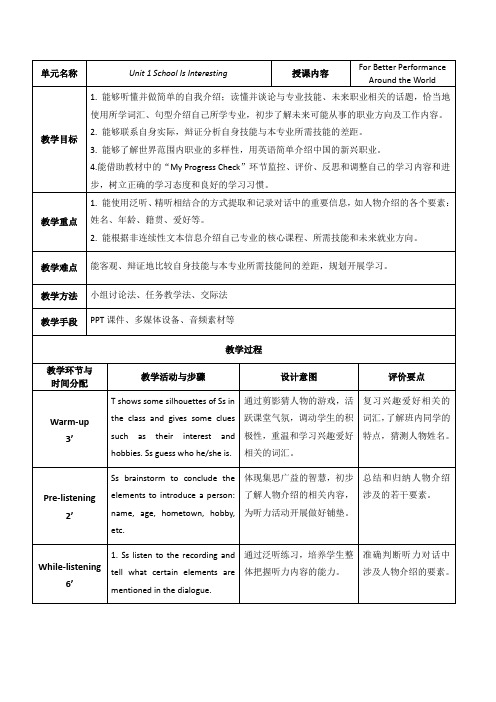
While-listening
6’
1.Sslisten to the recording and tell whatcertain elements are mentioned in the dialogue.
通过泛听练习,培养学生整体把握听力内容的能力。
准确判断听力对话中涉及人物介绍的要素。
在语境中轻松掌握语音知识,通过朗读、比较和分析,明确相近元音的发音异同点。
正确朗读例句,掌握俗语的中文大意,明确/i:/和/i/的异同点。
Summary
&
Homework
3’
Summary:With the help of T,Sstry to sort out the knowledge points and have the assessment in “My Progress Check”.
复习兴趣爱好相关的词汇,了解班内同学的特点,猜测人物姓名。
Pre-listening
2’
Ssbrainstorm to conclude the elements to introduce a person: name, age, hometown, hobby,etc.
体现集思广益的智慧,初步了解人物介绍的相关内容,为听力活动开展做好铺垫。
引导学生综合运用略读和扫读的阅读策略,了解文章大意,发表个人看法,学会根据上下文猜测词义,提高阅读效率。
略读和扫读文章,根据所给图片猜测小标题大意,并通过上下文猜测文中词义,谈论自己感兴趣的专业。
2. Ssshare their ideas on other interesting majors. T helps Ss to talk about the interesting majors by following the given passage.
英语基础模块上册教案Unit1
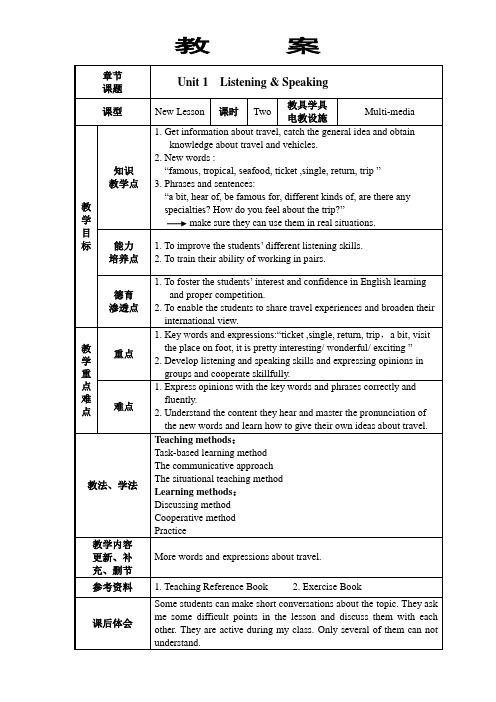
渗透点
1. To foster the students’ interest and confidence in Englishlearningand proper competition.
2. To enable the students to share travel experiences and broaden their international view.
难点
1. Express opinions with the key words and phrases correctly and fluently.
2. Understand the content they hear and master the pronunciation of the new words and learn how to give their own ideas about travel.
1) Let students listen to the conversation and tick(√) the answer.
1. Tiger Hill inSuzhou
2. Museums inNanjing
3. Tropical beaches in Sanya
Prepare for the new lesson.
教案
章节
课题
Unit 1 Listening& Speaking
课型
New Lesson
课时
Two
教具学具
电教设施
Multi-media
教学目标
知识
教学点
1. Get information about travel, catch the general idea and obtain knowledge about travel and vehicles.
英语基础模块1 学生用书B1U2P1 教案

happened.
进内容理解。
7. T tells Ss that the girl in the 培养学生理解细节的听力 采用记笔记策略提取 picture was a bit down because 策略,通过记笔记,提升学 细节信息,找到女孩情 something happened to her. Ss 生信息判断和关键信息的 绪低落的原因。 listen to the dialogue and take 提取能力。 down notes to find out the reason.
间发生的动作或存在
being in a time before now.
的状态。
Post-listening 15’
1. Ss work in groups and discuss 引导学生站在当事人朋友 小组讨论,说明原谅或
about the following question:
的角度思考问题,鼓励呈现 不原谅琳恩的原因。
work in pairs to act out new 现语言的控制性输出。
话。
dialogues.
6. T shows the picture in Activity 听前看图预测主题,缩小预 猜测图片中人物的情
Four. Ss discuss and guess what 测范围,提高听的效率,促 绪和可能经历的事情。
in the pictures.
能力。
2. Ss listen to the recording and 通过图、词、音、义的对应, 正确对应活动图片和 catch the activities they’ve 帮助学生回顾旧知,整理有 相关英文表达。 heard. Match pictures with the 关社交活动的短语。 relevant phrases in Activity One.
中职英语(基础模块)教案
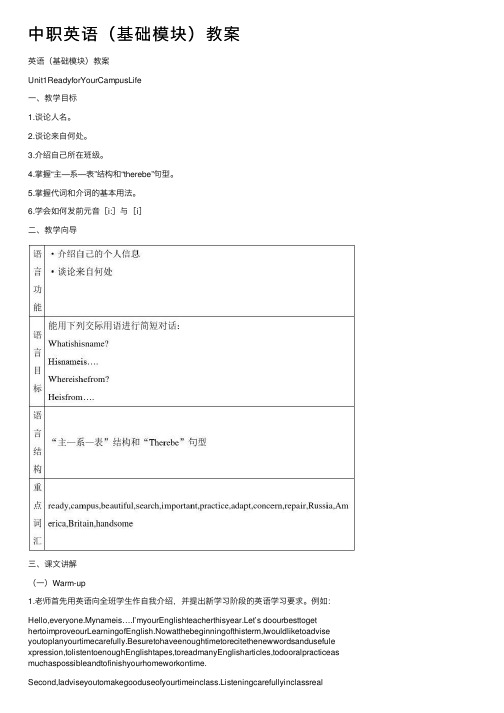
中职英语(基础模块)教案英语(基础模块)教案Unit1ReadyforYourCampusLife⼀、教学⽬标1.谈论⼈名。
2.谈论来⾃何处。
3.介绍⾃⼰所在班级。
4.掌握“主—系—表”结构和“therebe”句型。
5.掌握代词和介词的基本⽤法。
6.学会如何发前元⾳[i:]与[i]⼆、教学向导三、课⽂讲解(⼀)Warm-up1.⽼师⾸先⽤英语向全班学⽣作⾃我介绍,并提出新学习阶段的英语学习要求。
例如:Hello,everyone.Mynameis….I’myourEnglishteacherthisyear.Let’s doourbesttoget hertoimproveourLearningofEnglish.Nowatthebeginningofthisterm,Iwouldliketoadvise youtoplanyourtimecarefully.Besuretohaveenoughtimetorecitethenewwordsandusefule xpression,tolistentoenoughEnglishtapes,toreadmanyEnglisharticles,todooralpracticeas muchaspossibleandtofinishyourhomeworkontime.Second,Iadviseyoutomakegooduseofyourtimeinclass.Listeningcarefullyinclassreallymeanslessworklater.Takingnoteswillhelptoremindyouwhattheteachersaid. AnotherimportantsuggestionisthatyoushoulddevelopagoodattitudetowardsyourEnglishreading,listening,speakingandwriting.Don’tbeafraidofmakingmistakeswhenyouarespeakingEnglish.JusttryyourbesttosaywhatyouwantinEnglisheverytime.I’lldomybesttohelpyouandIhopeeveryonewillgetagreatprogressintheshortestpossib letime….此外,还可以设计⼀些常⽤⼝令、⼿势、规定⼀些纪律,以便在以后的教学中,形成良好的习惯,达成默契。
- 1、下载文档前请自行甄别文档内容的完整性,平台不提供额外的编辑、内容补充、找答案等附加服务。
- 2、"仅部分预览"的文档,不可在线预览部分如存在完整性等问题,可反馈申请退款(可完整预览的文档不适用该条件!)。
- 3、如文档侵犯您的权益,请联系客服反馈,我们会尽快为您处理(人工客服工作时间:9:00-18:30)。
Unit 9 What club would you like to join?
【教学目标】
●语言知识目标:学生能够理解并运用与加入俱乐部或参加某项活动相关的
词汇和句式完成信息的询问和获取,表格的填充和理由的表叔,并能够用一般将来时表述未来计划。
●语言技能目标:
听——学生能够听懂有关加入俱乐部和询问相关信息对话。
说——学生能够用what club would you like to join?等句式就加入俱乐部的话题进行问询和交流。
读——学生能够读懂有关介绍俱乐部活动的海报。
写——学生能够写出加入俱乐部的相关信息并写出加入理由。
【教学步骤】
Period 1
●Step 1 lead-in
1.“本单元我们将要学习关于加入俱乐部的知识。
Today we are going to learn
a new unit。
”
板书本单元的标题“what club would you like to join?”
2. 提问学生学校有哪些俱乐部。
可能会出现的词:student union 学生会;kickboxing club 跆拳道俱乐部;chorus 合唱团;badminton club 羽毛球俱乐部;table tennisclub乒乓球俱乐部;track and field 田径; literary club 文学俱乐部;chess club 国际象棋俱乐部
●Step 2 learn the new words
学习新单词以便接下来完成接下来的内容。
跟读两遍,学生自己读一遍,给5分钟时间学生自己记单词。
再读多一遍。
●Step 3 read and choose
1.个人活动。
学生先自己看图片,理解图中俱乐部的名称。
2.阅读右侧广告语。
理解表达的意思,并与相应的俱乐部匹配。
提示学生根
据俱乐部的名称去理解广告语。
3.全班活动。
教师让学生就搭配好的图片与广告语进行展示。
4.鼓励学生大胆想象。
提问学生生活中还有哪些常见的广告语。
●Step 4 read and thick
1.教师与学生一起分析课本中参加英语俱乐部可能应该具备的资格。
2.学生自己思考并选出自己认为参加英语俱乐部应该具备的资格有哪些。
3.抽查两名学生,说出他们认为参加英语俱乐部应该具备的资格有哪些。
Period 2
Dialogue A
●Step 1 listen and tick
1.与学生一起分析课本中提供的俱乐部名称。
引导学生熟悉待选俱乐部名
称。
2.学生听录音,选出张伟要参加的俱乐部。
播放两遍。
3.教师抽查学生并反馈。
●Step 2 listen and complete
1.与学生一起分析听力要求记录的内容有哪些。
2.放录音,要求学生边听录音边记下相关信息。
3.录音播放第二遍,与同桌讨论答案,然后提问并给出反馈。
●Step 3 read and underline
1.要求学生先自己阅读一遍对话,然后与同桌一起讨论并标出申请参加俱乐
部时会使用的语句。
2.提问并反馈。
3.就画出的句子“I’d like to join…”延伸出表达“想要做某事”的其他表达
法。
I’d like to do…
I’d love to do…
I feel like doing…
给出例句,要求学生说出其他的表达方法
Eg: 1. I’d like to go to the zoo this weekend.
2. I’d like to have a cup of tea.
4. 逐句带读一遍对话。
再要求学生读一遍。
Dialogue B
●Step 1 listen and match
1. 提问学生列出的分别有哪些俱乐部。
引导学生熟悉俱乐部名称。
2. 播放录音两遍,学生根据录音确定答案。
3. 点名抽查核对答案。
●Step 2 listen and complete
1. 引导学生分析听力的问题,并根据问题有选择地抓住听力的细节信息。
2. 放录音,学生补全句子。
听力播放两遍。
3. 点名抽查再次播放录音核对答案。
●Step 3 read and underline
1.要求学生先自己阅读一遍对话,然后与同桌一起讨论并标出询问俱乐部信
息使用的语句。
2.提问并反馈。
4. 逐句带读一遍对话。
再要求学生读一遍。
●Step 4 act and practice
1.“Now you’re preparing to join a club. Please make a conversation with your
parterner about interviewing a new member of your club.”
讲解所给的俱乐部名称及句型,确定对话的内容和语句。
2.两人一小组,一人作为面试者,询问参加面试的同学的意向以及具备的资
格,并提供相关的俱乐部信息。
3.邀请三组学生进行情况汇总,教师作点评。
●Step 5 everyday English
Period 4
●Step 1 lead-in
1.发散思维,思考校园内常见的社团或俱乐部宣传张贴的海报中有哪些内
容。
What items should be included to make a club poster?
●Step 2 read and tick
1.引导学生说出表格中各选项的含义。
2.学生快速阅读海报,根据获得的信息在表中勾出提到的俱乐部名称。
3.全班核对答案。
●Step 3 read and complete
1.仔细阅读海报,与同桌一起讨论海报的内容和信息表达方式,在表中填入
相应的信息。
2.点名检查。
全班核对。
3.讲解海报内容及格式。
●Step 4 read and choose
1.学生自己阅读个人表述,确定人物的活动意向,为他们在上述的海报中选
择合适的俱乐部。
2.点名检察学生完成情况。
●Step 5 think and write
Do it as homework.
Period 5
●Step 1 grammar focus
1.发散思维,提问两名学生周末有什么安排。
引出本单元学习的语法内容为
一般将来时的形式和用法。
2.学生自己阅读课本上的例句,熟悉一般将来时表达的形式。
3.教师板书。
用表格总结一般将来时的形式及用法。
4.解释一般将来时的含义。
具体参照课本172页内容。
一般将来时表示将来某一时刻的动作或状态,或将来某一段时间内经常的动作或状态。
常常和表示将来的时间状语连用。
如:tomorrow(明天),next week(下周);in the future(将来)等。
一般将来时由助动词will+动词原形构成。
或用主语+be going to+动原.
①肯定句:主语+ be going to do/will+ 动词原形
②否定句:主语+ be not going to do / will not+ 动词原形
③疑问句:Be动词+主语+ going to do /Will+主语+ 动词原形
简略回答:(肯)Yes,主语shall/will (否) No,主语shall/will not
④特殊疑问句:一般将来时的特殊疑问句是将疑问词放在句首,后接一般疑
问句(就主语提问时,以疑问词who开头的疑问词除外)
5. 朗读例句。
●Step 2 read and complete
1.学生阅读句子填空。
2.请五名学生在黑板上写出答案,全班核对答案并反馈。
●Step 3 talk and write
1.引导学生阅读例句,根据例句把握对将来活动的询问和回答方式练习对
话。
2.两人轮流问,将同桌放学后会做的三件事记录下来。
3.采用提问方式进行检查反馈。
Period 6
●Step 1 think and choose
1.学生想出一个俱乐部的名称,仿照133页海报,选择合适的用来宣传俱乐
部的词语写在横线上。
2.抽查三名学生,全班反馈。
●Step 2 read and complete
1.学生读对话,根据语境选择合适的词句补充对话。
2.全班核对答案。
3.朗读对话。
